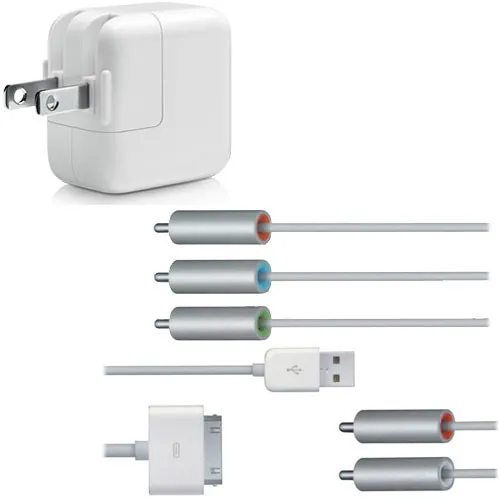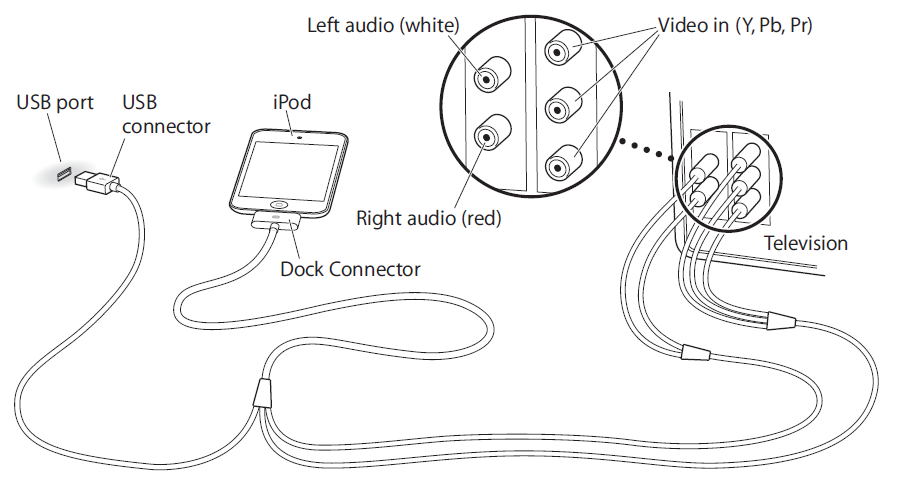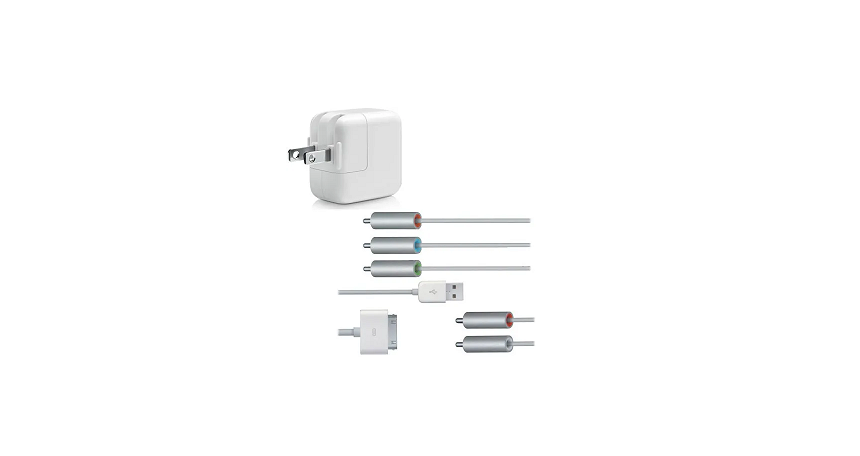APPLE Component AV Cable User Manual

Component AV Cable
Use the Component AV Cable to connect your iPod, iPhone, or iPad to the component video and analog audio ports on your TV, home theater receiver, or stereo receiver. The Component AV Cable features a USB connector that you can plug into a power source, such as a computer or a USB Power Adapter.
Before you begin connecting components, turn down the volume on iPod, iPhone, or iPad, and turn off the power to all your components. Remember to make all connections firmly to avoid humming and noise.
Important: Never force a connector into a port. If the connector and port don’t join with reasonable ease, they probably don’t match. Make sure the connector matches the port and is positioned correctly in relation to the port.
To use the Component AV Cable to connect iPod, iPhone, or iPad to your TV or receiver:
- Plug the red, green, and blue video connectors into the component video input (Y, Pb, and Pr) ports on your TV or receiver.
- Plug the white and red audio connectors into the left and right analog audio input ports, respectively, on your TV or receiver.
- Plug the iPod Dock Connector into your iPod, iPhone, iPad, or Universal Dock.
- Plug the USB connector into a USB Power Adapter or your computer to keep your iPod, iPhone, or iPad charged.
- Turn on iPod, iPhone, or iPad and your TV or receiver to start playing.
OVERVIEW

Make sure you set iPod, iPhone, or iPad to send a video signal out to your TV or receiver.
For more information, see the user guide for your device.
The ports on your TV or receiver may differ from the ports in the illustration.
Note: If your iPod doesn’t support video, you can use the Component AV Cable for audio output, syncing content, and charging.
Regulatory Compliance Information
FCC Compliance Statement
This device complies with part 15 of the FCC rules. Operation is subject to the following two conditions: (1) This device may not cause harmful interference, and (2) this device must accept any interference received, including interference that may cause undesired operation. See instructions if interference to radio or television reception is suspected.
Radio and Television Interference
The equipment described in this manual generates, uses, and can radiate radio-frequency energy. If it is not installed and used properly—that is, in strict accordance with Apple’s instructions—it may cause interference with radio and television reception.
This equipment has been tested and found to comply with the limits for a Class B digital device in accordance with the specifications in Part 15 of FCC rules. These specifications are designed to provide reasonable protection against such interference in a residential installation. However, there is no guarantee that interference will not occur in a particular installation.
You can determine whether your computer system is causing interference by turning it off. If the interference stops, it was probably caused by the computer or one of the peripheral devices. If your computer system does cause interference to radio or television reception, try to correct the interference by using one or more of the following measures:
- Turn the television or radio antenna until the interference stops.
- Move the computer to one side or the other of the television or radio.
- Move the computer farther away from the television or radio.
- Plug the computer into an outlet that is on a different circuit from the television or radio.
(That is, make certain the computer and the television or radio are on circuits controlled by different circuit breakers or fuses.)
If necessary, consult an Apple Authorized Service Provider or Apple. See the service and support information that came with your Apple product. Or, consult an experienced radio or television technician for additional suggestions.
Important
Changes or modifications to this product not authorized by Apple Inc. could void the FCC compliance and negate your authority to operate the product. This product was tested for FCC compliance under conditions that included the use of Apple peripheral devices and Apple shielded cables and connectors between system components. It is important that you use Apple peripheral devices and shielded cables and connectors between system components to reduce the possibility of causing interference to radios, television sets, and other electronic devices.
You can obtain Apple peripheral devices and the proper shielded cables and connectors through an Apple authorized dealer. For non-Apple peripheral devices, contact the manufacturer or dealer for assistance.
Responsible party (contact for FCC matters only): Apple Inc. Corporate Compliance 1 Infinite Loop, MS 26-A Cupertino, CA 95014
Industry Canada Statements
Complies with the Canadian ICES-003 Class B specifications. This device complies with RSS 210 of Industry Canada. This Class B device meets all requirements of the Canadian interference-causing equipment regulations.
European Compliance Statement
This product complies with the requirements of European Directives 72/23/EEC, 89/336/EEC, and 1999/5/EC.
Disposal Information
The symbol above means that according to local laws and regulations your product should be disposed of separately from household waste. When this product reaches its end of life, take it to a collection point designated by local authorities. Some collection points accept products for free. The separate collection and recycling of your product at the time of disposal will help conserve natural resources and ensure that it is recycled in a manner that protects human health and the environment.
FAQS
Q: What is the Apple Component AV Cable?
A: The Apple Component AV Cable is an accessory that allows you to connect your Apple device, such as an iPhone, iPad, or iPod, to a TV or other display using component video and analog audio connections.
Q: What devices are compatible with the Apple Component AV Cable?
A: The Apple Component AV Cable is compatible with older Apple devices that have a 30-pin dock connector, such as the iPhone 4s, iPhone 4, iPhone 3GS, iPhone 3G, iPad (1st generation), and iPod touch (4th and earlier generations). It is not compatible with newer devices that use Lightning connectors.
Q: What connections does the Apple Component AV Cable have?
A: The cable has three color-coded connectors: red, green, and blue for component video, and red and white for analog audio. These connectors need to be plugged into corresponding ports on your TV or display.
Q: Can I use the Apple Component AV Cable to stream audio or video from my Apple device?
A: No, the Apple Component AV Cable is designed for connecting your device to a TV or display to mirror the device’s screen or play videos and photos stored on the device. It does not support streaming content or playing DRM-protected videos.
Q: Can I charge my Apple device while using the Apple Component AV Cable?
A: No, the Apple Component AV Cable does not have a separate charging capability. If you need to charge your device while using it with the cable, you will need to connect a separate charging cable to the device.

